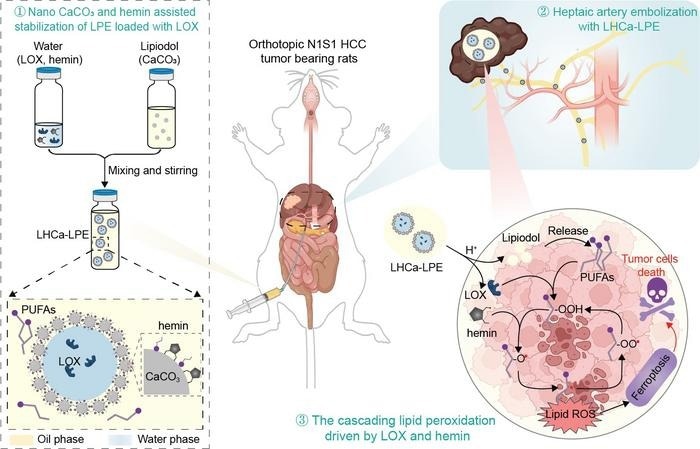Hepatocellular carcinoma (HCC) is currently the third leading cause of cancer-related mortality across the globe. Transarterial embolization (TAE) therapy is the standard of care for most patients with intermediate-advanced HCC. Its minimum invasiveness stems from its use of embolic agents to limit the tumor blood supply and produce ischemic necrosis. Transarterial chemoembolization (TACE), which mixes chemotherapy drugs with embolic agents, is also widely used in clinical treatment to increase therapeutic benefit.
 A schematic diagram showing the preparation of a pH-responsive Lipiodol Pickering emulsion-based microreactor for transarterial ferro-embolization therapy of HCC. Image Credit: Science China Press
A schematic diagram showing the preparation of a pH-responsive Lipiodol Pickering emulsion-based microreactor for transarterial ferro-embolization therapy of HCC. Image Credit: Science China Press
Lipiodol is a frequently used liquid embolic agent for treating TAE among these clinically used embolic agents; it has also been used in combination with chemotherapy medicines to treat TACE. However, the quick drug diffusion from the embolization site caused by the low stability of this Lipiodol-drug emulsion significantly reduces the therapeutic efficacy of these chemotherapeutic medicines and imposes systemic toxicity.
Thus, the creation of a stable Lipiodol-drug emulsion with long-term drug release characteristics has enormous potential for better HCC treatment.
A collaborative research team led by Professor Zhuang Liu from Soochow University (Institute of Functional Nano & Soft Materials, FUNSOM) suggested a water-in-oil Lipiodol Pickering emulsion stabilized by calcium carbonate nanoparticles and hemin in a recent study published in National Science Review to address this difficult problem.
Due to the inclusion of CaCO3 nanoparticles, the resulting Lipiodol Pickering emulsion allowed for pH-responsive release of the encapsulated molecules and stable encapsulation of a variety of hydrophilic molecules in aqueous droplets compared to traditional Lipiodol emulsion.
The ability of lipoxygenase (LOX) to stimulate the production of cytotoxic lipid radicals from polyunsaturated fatty acids, a primary constituent of lipiodol, served as inspiration for the concise construction of a pH-responsive, self-fueling ferroptosis-inducing microreactor (known as LHCa-LPE) in which LOX was encapsulated in a lipiodol-based Pickering emulsion.
With lipiodol serving as the source of PUFAs, it was demonstrated that such LHCa-LPE could efficiently induce ferroptosis in cancer cells by the cascade lipid peroxidation chain reaction. Such LHCa-LPE, acting as dual-purpose embolic and ferroptosis-inducing agents, could successfully limit the growth of orthotopic N1S1 HCC in rats during transarterial embolization.
This study presents a simple method for creating a stable lipiodol-based embolic agent, which is also encouraging for possible clinical translation because all of the constituents of these emulsions have outstanding biocompatibility.
Journal Reference:
Wang, C., et al. (2023) Self-fueling ferroptosis-inducing microreactors based on pH-responsive Lipiodol Pickering emulsions enable transarterial ferro-embolization therapy. National Science Review. doi:10.1093/nsr/nwad257